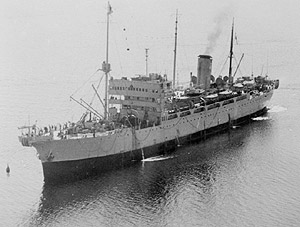September 24, 2006
Happy Birthday
An interesting fifty-year birthday is coming up this Tuesday, September 26th. From The Scotsman:Underwater connection that brought clarity to the westThis was an historic achievement if it had been done on dry land. To have done it under water where none of the electronics could be serviced makes it even more amazing. The electrical losses were so great that they had to have amplifiers every hundred miles or so -- the failure of one of these would shut down the cable. It operated for twenty two years.
It is a long and choppy way from Oban on the windswept west coast of Scotland to Clarenville on the east coast of Canada – 2,240 miles to be precise. But thanks to a cable stretched out two miles below the cold Atlantic Ocean, Scotland's links to North America became if not physically closer, then a lot clearer, 50 years ago this month.
The first transatlantic submarine cable went live at 6pm on 25 September 1956 – instantly trebling the number of calls that could be made between the UK and the United States or Canada and giving customers vastly improved sound quality. The cable, which replaced unreliable, crackly radio links, allowed for 36 simultaneous transatlantic conversations.
Amazingly, considering that it cost the princely sum of £3 for three minutes – today the same call would cost less than 30p – the cable carried almost 300,000 calls in its first year of service.
The cost reflected the huge investment and technological difficulties of installing the cable, in a joint initiative between the Post Office Engineering Department, the American Telegraph and Telephone Company (AT&T), Bell Telephone Laboratories and the Canadian Overseas Telecommunications Corporation.
Fifty per cent of the shares were held by the American companies, 40 per cent by the Post Office Telecommunications and 10 per cent by the Canadians.
The project was extremely ambitious, with two armoured sub-sea cables developed by Bell Laboratories used to connect Oban with Clarenville. The cable was laid by the cableship Monarch – built by the Post Office in 1945 to replace a vessel of the same name destroyed during the war - and it was the only ship capable of conveying the 1,500 nautical miles of cable which had to be laid in one piece across the deepest part of the Atlantic.
The Oban end of the cable was then connected to Glasgow and London, with the Clarenville end linked to Newfoundland and on to Nova Scotia.
"The advent of the first transatlantic cable, which was nicknamed TAT1, was hailed as a major breakthrough in telecommunications and heralded the age of reliable and cost effective mass communication across the Atlantic," says David Hay, BT's head of heritage and corporate memory.
Using technologies developed during and after the Second World War, the cable cost £12.5 million to lay and took three years to complete. Hay adds: "By any standards this was a historically significant engineering achievement."

Posted by DaveH at September 24, 2006 8:17 PMHMTS Monarch, the ship that laid the first transatlantic telephone cable.
Picture: BT Heritage
Comments
Post a comment